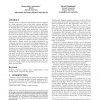Free Online Productivity Tools
i2Speak
i2Symbol
i2OCR
iTex2Img
iWeb2Print
iWeb2Shot
i2Type
iPdf2Split
iPdf2Merge
i2Bopomofo
i2Arabic
i2Style
i2Image
i2PDF
iLatex2Rtf
Sci2ools
PVLDB
2008
2008
Finding relevant patterns in bursty sequences
Sequence data is ubiquitous and finding frequent sequences in a large database is one of the most common problems when analyzing sequence data. Unfortunately many sources of sequence data, e.g., sensor networks for data-driven science, RFID-based supply chain monitoring, and computing system monitoring infrastructure, produce a challenging workload for sequence mining. It is common to find bursts of events of the same type. Such bursts result in high mining cost, because input sequences are longer. An even greater challenge is that these bursts tend to produce an overwhelming number of irrelevant repetitive sequence patterns with high support. Simply raising the support threshold is not a solution, because at some point interesting sequences will get eliminated. As an alternative we propose a novel transformation of the input sequences. We show that this transformation has several desirable properties. First, the transformed data can still be mined with existing sequence mining algori...
Mining | PVLDB 2008 | Sequence Data | Sequences |
| Added | 28 Dec 2010 |
| Updated | 28 Dec 2010 |
| Type | Journal |
| Year | 2008 |
| Where | PVLDB |
| Authors | Alexander Lachmann, Mirek Riedewald |
Comments (0)

